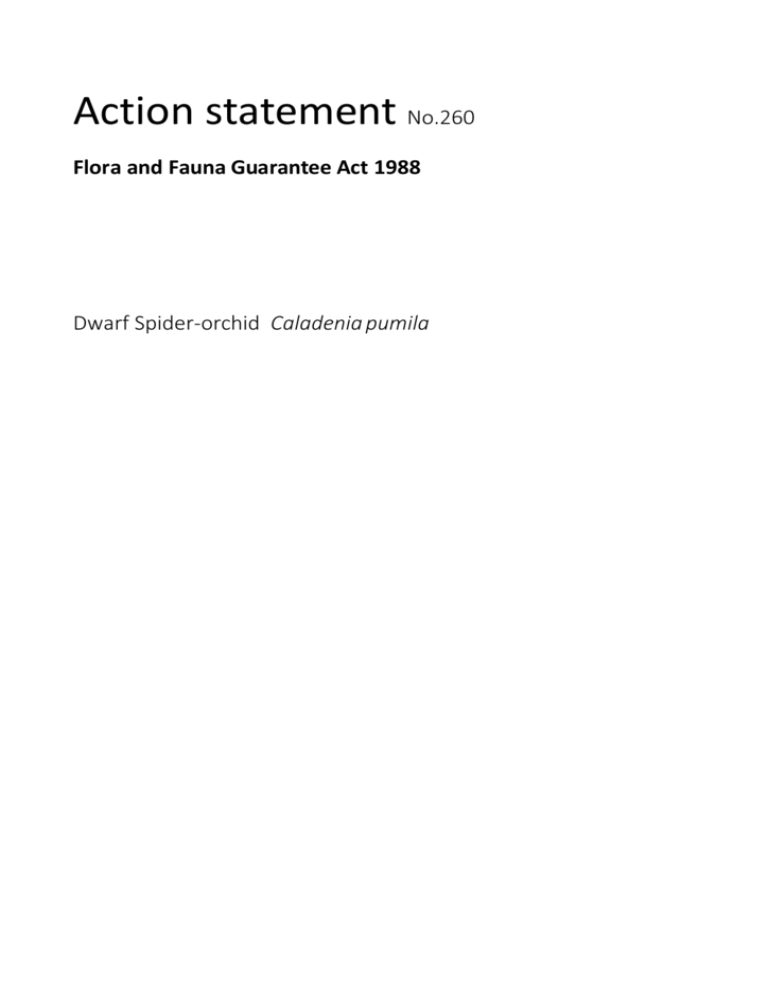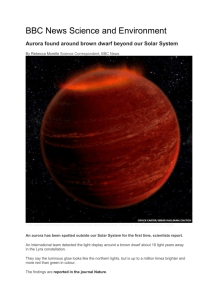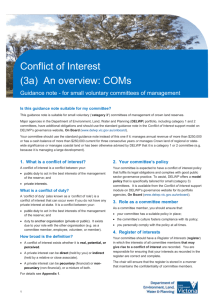Dwarf Spider-orchid (Caladenia pumila)
advertisement

Action statement No.260 Flora and Fauna Guarantee Act 1988 Dwarf Spider-orchid Caladenia pumila © The State of Victoria Department of Environment, Land, Water and Planning 2015 This work is licensed under a Creative Commons Attribution 4.0 International licence. You are free to re-use the work under that licence, on the condition that you credit the State of Victoria as author. The licence does not apply to any images, photographs or branding, including the Victorian Coat of Arms, the Victorian Government logo and the Department of Environment, Land, Water and Planning (DELWP) logo. To view a copy of this licence, visit http://creativecommons.org/licenses/by/4.0/ Cover photo: Mike Duncan Compiled by: Mike Duncan ISBN: 978-1-74146-776-5 (pdf) Disclaimer This publication may be of assistance to you but the State of Victoria and its employees do not guarantee that the publication is without flaw of any kind or is wholly appropriate for your particular purposes and therefore disclaims all liability for any error, loss or other consequence which may arise from you relying on any information in this publication. Accessibility If you would like to receive this publication in an alternative format, please telephone the DELWP Customer Service Centre on 136 186, email customer.service@delwp.vic.gov.au, or via the National Relay Service on 133 677, email www.relayservice.com.au. This document is also available on the internet at www.delwp.vic.gov.au Action Statement No. 260 Dwarf Spider-orchid Caladenia pumila Description Dwarf Spider-orchid (Caladenia pumila R.S. Rogers) is a medium-sized, very short, pale-clubbed spider orchid, growing to 15 cm tall (though often much less). It has a single, lanceolate, fleshy basal leaf (60 - 70 x 10 - 15 mm) which is covered in hairs on both surfaces. It has a single crystalline white flower (50 - 60 mm across) with pink labellum calli and margin (including marginal teeth). The sepals and petals are up to 40 mm long, relatively broad at the base, then tapering to short fine tails (petals) or ending in short indistinct green clubs (sepals). The dorsal sepal is erect, while the lateral sepals are widely spreading, deflexed, and the tips curve under. The petals are backswept, shallowly deflexed, and the tips are down-curved. The labellum is relatively broad (approximately 17mm long by 8 mm wide) and the upper surface is covered with 4 - 6 rows of short, fine, widely spaced calli, which extend to the base of mid-lobe. The margins of the labellum have a few irregular, small, widely spaced teeth at the base of the mid-lobe, but the labellum is otherwise smooth (Rogers 1922, Nicholls 1932, Backhouse and Jeanes 1995, Jeanes and Backhouse 2006, Jones 2006, Backhouse 2011). The Dwarf Spider-orchid flowers in September and October, and can be easily distinguished by its short stature; small, single, white flower with pink markings; short clubs on the sepals; and nearly entire labellum margins. 1926 due to the loss of its grassy woodland habitat (Rogers 1922, Nicholls 1932, Backhouse and Jeanes 1995, Jeanes and Backhouse 2006, Jones 2006, Backhouse 2011). There are no confirmed records of this species occurring at the Bannockburn site beyond this time. A new population of this species was discovered in September 2009 when two plants were found in the Inverleigh Nature Conservation Reserve (Inverleigh NCR). All known plants of this species occur within the Victorian Volcanic Plains IBRA Bioregion and the Corangamite Natural Resource Management Region. Habitat The Dwarf Spider-orchid was previously known from a single population at Bannockburn, south-western Victoria, where it was once considered to be locally common. However, it had all but disappeared by The Bannockburn population of the Dwarf Spiderorchid was confined to hillsides and rushy flats in grassland, woodland or open forest (Backhouse and Jeanes 1995). The current population occurs in grassy herb-rich woodland with scattered shrubs, on a flat grassy area with grey sandy loam soil, approximately 50 m from a seasonal watercourse (Backhouse 2011). Associated species include: Hedge Wattle (Acacia paradoxa), Pale Vanilla-lily (Arthropodium strictum), Blue Stars (Chamaescilla corymbosa), Common Everlasting (Chrysocephalum apiculatum), Red Parrot-pea (Dillwynia hispida), Golden Moths (Diuris chryseopsis), Scented Sundew (Drosera aberrans), River Red-gum (Eucalyptus camaldulensis), Manna Gum (Eucalyptus viminalis subsp. viminalis), Clover Glycine (Glycine latrobeana), Bent Goodenia (Goodenia geniculata), Running Postman (Kennedia protrata), Weeping Grass (Microleana stipoides var. stipoides), Common Rice-flower (Pimelea humilis), Creamy Stackhousia (Stackhousia monogyna), Kangaroo Grass (Themeda Dwarf Spider-orchid (Donna McMaster) Distribution in Victoria (DELWP, 2015) Distribution Action statement No. 260 Dwarf Spider-orchid 3 triandra), and Common Early Nancy (Wurmbea dioica subsp. dioica). Life History and Ecology The Dwarf Spider-orchid is a deciduous herb that emerges annually from a spherical, underground tuber that is protected by a tough, fibrous tunic. These tubers are replaced annually and are dormant during the drier summer months. The basal leaf emerges in early winter following soaking rains in autumn. Flowering commences in the second half of September. Flowers remain open for a few days to a few weeks depending on pollination and climatic factors. The plants reproduce solely from seed, and the fruits usually take 5 to 8 weeks to mature following pollination. Each mature capsule may contain thousands of microscopic seeds that are dispersed by wind when the capsule dries out (Backhouse and Jeanes 1995, Jeanes and Backhouse 2006, Jones 2006, Backhouse 2011). Little is known of the biology and ecology of the Dwarf Spider-orchid, however, it is likely to be similar to other south-eastern Australian members of the genus. Most spider orchids grow in a complex relationship with mycorrhizal fungi (Warcup 1981). The fungus assimilates some nutrients for the orchid, but the degree of dependence upon the fungus is not known. Longevity is generally unknown, although individuals of Melblom’s Spiderorchid (C. hastata) have been known to survive for at least 17 years in the wild (Carr 1999). Pollination is via sexual deception through the process of pseudocopulation. Spider orchids are characterised by their often large, attractive flowers. Petals and sepals often have a dense apical covering of glands that emit pheromones to attract pollinators, usually male thynnid wasps (Backhouse and Jeanes 1995, Jeanes and Backhouse 2006, Jones 2006). A male usually attempts to copulate with the labellum, mistaking it for the female wasp, and effecting pollination. While thynnid wasps are the most likely pollinators, the identities of the pollinator(s) for some spider orchids are not known. Some native bee species have been identified as the pollinators of some pink coloured spider orchids such as Little Pink Spider-orchid (C. rosella). Observations of Caladenia species suggest that the period available for effective pollination may be as little as a few days. Successful pollination may be influenced by the receptiveness of the stigma to pollen, the number of pollinators in an area, insect behaviour and climatic conditions. It has been suggested that pollinators may become habituated to the flowers in their territory and avoid them, leading to a decline in the pollination rate (Bower 1992). The attempted copulation (pollination) rate by wasps has been shown to be as low as 7.5% for some Caladenia species (Peakall and Beattie 1996) while it is possible that non-synchronous flowering may prevent pollination in some species. These factors may be important when considering species with a critically low population size. The role of fire in the ecology of many spider orchids is not understood, but is likely to be important, as many Caladenia species exhibit strong flowering responses in the years following fire. Fire is an integral part of the physical environment of most vegetation types in southern Australia (Gill et al. 1999), and is required to maintain plant diversity (Wark 1996). Light levels and temperature at ground level increase following removal of surrounding vegetation by fire (Purdie 1977), while competition for light and nutrients has been shown to decrease with the reduction or removal of the surrounding vegetation (Gill et al. 1981). Seedling establishment may be critically dependent on fire. The timing of fire is also important, with the best time for most Caladenia species being summer or early autumn, after seed dispersal but prior to new shoot growth. The variation in seasonal climatic conditions, most notably rainfall and temperature also influences flowering. For example, flower development and/ or flowering is often aborted during periods of sustained hot, dry weather. Conservation status National conservation status The Dwarf Spider-orchid has been listed as critically endangered under the Commonwealth Environment Protection and Biodiversity Conservation Act 1999 (EPBC Act). Victorian conservation status The Dwarf Spider-orchid has been listed as threatened under the Flora and Fauna Guarantee Act 1988. The Dwarf Spider-orchid is considered endangered in Victoria according to the Department of Environment, Land, Water and Planning (DELWP)’s Advisory List of Rare or Threatened Plants in Victoria - 2014 (DEPI 2014). Action statement No. 260 Dwarf Spider-orchid 4 Threats A number of threats are either currently acting or have the potential to impact on the Dwarf Spider-orchid population. These threats include trampling by people, or grazing animals, herbivory by native and introduced species, illegal collection, competition with native species, inappropriate fire regimes, a lack of genetic diversity, and climate change. The decline of the Bannockburn population of the Dwarf Spider-orchid followed considerable development which led to the destruction of the majority of natural habitat in the region (Jeanes and Backhouse 2006). However land use change and (legal) timber harvesting are no longer considered a threat to this species because all known plants occur within a reserve. Small-scale illegal firewood collection however is a potential threat. Standard threat Source of threat Explanation Herbivory Animals introduce d herbivores Rabbits (Oryctolagus cuniculus) and European Hares (Lepus europeaus) have been observed browsing in the reserve and are known to have impacted on other Caladenia species (N. Anderton pers. comm. 2012). The likelihood of unprotected Dwarf Spider-orchid flowers being browsed in the reserve is high. Animals - native species Macropods, White-winged Choughs (Corcorax melanorhamphos) and possums have been observed browsing in the reserve and are known to have impacted on other Caladenia species (N. Anderton pers. comm. 2012). Invertebrate eggs have been found on the stem of the Dwarf Spider-orchid while the pod was developing (N. Anderton pers. comm. 2013). The likelihood of unprotected Dwarf Spider-orchid flowers being browsed is high. Inappropriate fire regimes Fire – season or frequency An inappropriate fire regime (spring or late autumn burn) is likely to have a negative effect on this species, as it has done for other Caladenia species. The Dwarf Spider-orchid’s reproductive potential is likely to be reduced if fire partially or totally destroys flowering plants. The impact will be exacerbated if burning during spring or late autumn occurs in sequential years. Loss of important habitat features Smothering by other native species Juvenile Hedge Wattle plants are appearing in the natural grassy clearing occupied by the Dwarf Spider-orchid, and are a threat to the species without ongoing control. In addition, the caged and fenced areas containing the Dwarf Spiderorchid plants need to be maintained so that they remain as close as possible to the pre-cage/fence grazing regime (when the orchid is dormant), to prevent changes in the composition and volume of biomass. This is currently being achieved by opening the gates to the fenced area, to allow macropod grazing, during the summer dormancy period of the orchid. Taking by humans Illegal taking (trapping, poisoning, collecting) Given that there are only two known Dwarf Spider-orchid plants, and that this species is attractive and distinctive, illegal collection is a potential threat to the species. The propagation and re-introduction of additional plants is planned for the future, and this will ease the pressure of illegal collection on the wild plants. Action statement No. 260 Dwarf Spider-orchid 5 Genetic decline Genetic decline other Low genetic diversity is a threat to the survival of this species as there are only two known plants. Soil disturbance (physical) Trampling The reserve containing all known Dwarf Spider-orchid plants is used for a range of activities including, bushwalking and camping. Illegal firewood collection also occurs. All of these activities have the potential to damage or destroy the remaining Dwarf Spider-orchid plants, particularly during the flowering season, by direct trampling or by causing soil compaction around the known plants. Accidental trampling by orchid enthusiasts or soil compaction around the known plants may also become a threat to the species as more people become aware of its location. Recreational activities – motorised (4WDs, trail bikes, boats etc) Trail-bike riding and 4WD vehicles are allowed in the reserve. Off road activities by these vehicles have the potential to damage or destroy the remaining Dwarf Spider-orchid plants, particularly during the flowering season, by direct trampling or by causing soil compaction around the known plants. Important locations Catchment Location name Land manager Bioregion CORANGAMITE Inverleigh Nature Conservation Reserve (NCR) Parks Victoria (PV) Victorian Volcanic Plain Past management actions Action Result explanation Conduct artificial pollination Both flowers were cross-pollinated by hand in 2009 and 2010. One flower was produced in 2011, 2012 and 2013. In total 6 seed pods have been produced. Collect mycorrhizal fungi The mycorrhizal fungus associated with wild plants was collected in 2009 as part of an ex situ propagation program. Collect reproductive material Seed for the ex situ propagation program was sourced by collecting two seed pods in 2009, and 1 seed pod each year in 2010, 2012, 2013 and 2014. Propagate seedlings and/or cuttings for reintroduction or reinforcement The ex situ propagation program commenced in 2009 and is continuing. Seed germination techniques have been used to propagate 28 ex situ Dwarf Spiderorchid seedlings in pots as of November 2013. Erect/maintain cages, fences or other structures to exclude native animals In September 2009, the wild plants were caged to protect them from browsing by macropods. A fence erected in May 2010 also helps to protect the plants against browsing by macropods. In October 2013, invertebrate eggs were found on the stem of the Dwarf Spider-orchid. These were removed and hatched ex-situ. Action statement No. 260 Dwarf Spider-orchid 6 Erect/maintain fence to exclude introduced animals A fence (100 x 100 m) was erected in May 2010 to protect against browsing including by Rabbits and European Hares, and accidental destruction of the plants/site. The cage placed around the plants in September 2009 also helped to protect the plants from browsing including by Rabbits and European Hares. Erect/maintain structures to restrict or control access Caging of the plants in September 2009 and fencing in 2010 was also undertaken to help protect them against accidental trampling. Manage and/or restore micro-habitat Biomass was reduced within the area of the cage by carefully hand cutting the vegetation to just above ground level during summer 2010/11 and 2011/12. Review conservation status The EPBC Act status of this species was reviewed and changed in 2011 from extinct to critically endangered. In addition, the Department of the Environment have produced a draft Conservation Advice document for the Dwarf Spider-orchid. The 2005 Victorian Advisory List status was also changed in 2014 from ‘presumed extinct’ to ‘endangered’. Conduct survey to locate additional populations Surveys for new plants/populations have been conducted every year from 2009 to 2013. Locations searched were: Inverleigh NCR. in 2009, 2010, 2012 and 2013; Dog Rocks in 2009 and 2013; Bannockburn Treatment Plant in 2011; Milton Street in 2011; Bannockburn Cemetery in 2011, Inverleigh Golf Club 2013. Maintain vegetation structure In 2011, 2012, 2013 and 2014 Parks Victoria contractors removed Hedge Wattle from inside the enclosure (cut and paint). This area will be maintained as grassland. A browsing management plan for the enclosure has been developed which calls for the gates to be opened when the Dwarf Spider-orchid plants are dormant, to allow native herbivores to browse the vegetation. In 2012, 2013 and 2014 Hedge Wattle was removed from outside the enclosure, these areas will be maintained as a grassy woodland. Control introduced animals A browsing management plan for the enclosure has been developed which calls for the gates to be closed when the Dwarf Spider-orchid plants are active. Parks Victoria has an ongoing rabbit control program in the reserve. Undertake threat monitoring Monitoring of both plants was established in September 2009 (plants were individually tagged) to identify current and/or emerging threats to the population. The plants are monitored three times a year. Undertake surveillance monitoring The monitoring program also increases knowledge of the biology and ecology of the Dwarf Spider-orchid. Control/reduce human disturbance Counting pads were set up at the main gate to the Dwarf Spider-orchid enclosure. The total count was 20 persons during September and October 2011. Surveillance of the Dwarf Spider-orchid was carried out at the site in 2012, 2013 and 2014 from September to November. A sign was erected on the fence that warns of the liability associated with disturbing this species. Action statement No. 260 Dwarf Spider-orchid 7 Liaise with stakeholder groups A Dwarf Spider-orchid working group was established in January 2011, and meets twice a year. The working group consists of staff from DELWP – Grampians Region, DELWP – Arthur Rylah Institute, Parks Victoria - You Yangs, and representatives from the Australasian Native Orchid Society (Victorian Group), as well as other ad hoc members such as Dr Mark Clements from CSIRO Canberra. A media release was prepared in relation to the rediscovery of this species in December 2009 (following successful seed collection), and it was widely circulated. A brief article was published in the bulletin of the Australasian Native Orchid Society (Victorian Group) in August 2011 to alert orchid enthusiasts to the fact that no plants were going to flower that year. This was to discourage unnecessary visitation. In 2013, an article was published in local papers requesting the public to report any possible sightings/ knowledge of the orchid. This aimed to increase knowledge of the Dwarf Spider-orchid. Conservation objectives Long term objective To ensure that the Dwarf Spider-orchid can survive, flourish and retain its potential for evolutionary development in the wild. Objectives of this Action Statement • To increase knowledge of biology, ecology or management requirements • To secure populations or habitat from potentially incompatible land use or catastrophic loss • To maintain or improve condition of habitat • To increase the number of populations or individuals Intended management actions The actions in this action statement have been developed taking into consideration relevant social and economic matters, as required under the FFG Act. These actions are designed to support the conservation, management or control of flora and fauna and the management of potentially threatening processes, which will assist in mitigating any impact of climate change on the Dwarf Spider-orchid, and will have no impact on greenhouse gas emissions. The intended management actions listed below are further elaborated in DELWP’s Actions for Biodiversity Conservation (ABC) system. Detailed information about the actions and locations, including priorities, is held in this system and will be provided annually to land managers and other authorities. Standard objective Objective explanation To increase knowledge of biology, ecology or management requirements Distribution of Dwarf Spider-orchid to be confidently determined within In-verleigh NCR and surrounding remnants so that management can be more targeted. Management actions to be adjusted where necessary to reflect threats identified through regular monitoring. Demonstrable increase in knowledge of the biology and/or ecology of the Dwarf Spider-orchid. Action statement No. 260 Dwarf Spider-orchid 8 Standard action Details Responsible agents Conduct survey to locate additional populations Survey potential habitat within Inverleigh NCR as well as nearby remnant vegetation during spring each year to locate new plants/populations. DELWP Undertake threat monitoring Continue to undertake the established monitoring program where all individuals are monitored three times annually to identify current and/or emerging threats. DELWP Undertake surveillance monitoring Continue to undertake the established monitoring program to increase knowledge of the biology and/ or ecology of the Dwarf Spider-orchid. DELWP Ensure records of species, communities and locations are documented on the relevant databases Ensure that DELWP information systems contain up to date information, including reporting all species records and progress on actions. DELWP Standard objective Objective explanation To secure populations or habitat from potentially incompatible land use or catastrophic loss Accidental loss of plants or damage to its habitat to be avoided through mainte-nance of effective communication between responsible agents, stakeholder groups, and land managers. Standard action Details Responsible agents Identify and document specific measures to mitigate a threatening process. Investigate options to discourage potentially damaging human activities, such as erecting/ maintaining signs, periodically locking gate, installing foot pad counters and installing motion capture cameras. PV, DELWP Establish/maintain working group Continue the twice yearly meetings of the Dwarf Spider-orchid working group, and change/expand membership to meet the needs of the recovery program. DELWP Liaise with stakeholder groups Continue liaising with stakeholder groups such as Parks Victoria, Friends of Inverleigh NCR, Australasian Native Orchid Society (Victorian and Geelong Groups), and interested individuals to minimise the threats to this species, and optimise the recovery efforts. DELWP Action statement No. 260 Dwarf Spider-orchid 9 Standard objective Objective explanation To maintain or improve condition of habitat Herbivory, accidental trampling, biomass accumulation, and soil compaction to be reduced to a level that maintains the Dwarf Spiderorchid habitat, and maximises the chance of natural pollination and seed production by this species. Standard action Details Responsible agents Control introduced animals Continue to undertake the rabbit control program in the reserve. PV, DELWP Control/reduce human disturbance Maintain the cage or fence protecting the Dwarf Spider-orchid population to minimise the chance of the Dwarf Spider-orchid plants being accidentally trampled or destroyed, or the soil around the plants being significantly compacted. PV, DELWP Erect/maintain fence to exclude introduced animals Continue to maintain the fence protecting the Dwarf Spider-orchid population so that browsing of Dwarf Spider-orchid flowers and/or leaves by introduced animals does not occur. PV, DELWP Erect/maintain cages, fences or other structures to exclude native animals Continue to maintain the cage protecting the Dwarf Spider-orchid population so that browsing of Dwarf Spider-orchid flowers and/or leaves by native animals does not occur. PV, DELWP Maintain vegetation structure Carefully manage the vegetation within the fenced enclosure so that biomass accumulation and/ or vegetation changes do not negatively impact upon any Dwarf Spider-orchid plants. Continue the existing program of Hedge Wattle removal (both inside and outside the enclosure) to stop this invasive indigenous species from colonising the site. In addition, due to the reduction in natural browsing levels within the enclosure, undertake periodic biomass reduction (e.g. ecological burn or slashing) PV, DELWP Manage and/or restore micro-habitat Carefully manage the vegetation within the cage so that biomass accumulation does not negatively impact upon any of the Dwarf Spider-orchid plants. Continue the existing program of careful vegetation removal (using scissors/small secateurs) while the Dwarf Spider-orchid plants are dormant in summer, annually or biannually DELWP Action statement No. 260 Dwarf Spider-orchid 10 Standard objective Objective explanation To increase the number of populations or individuals Number of Dwarf Spider-orchid individuals to be increased in the Inverleigh NCR population (either from natural/managed recruitment, or reintroduced plants). Ex situ population of Dwarf Spider-orchid plants to be established. At least one additional Dwarf Spider-orchid population to be established in the wild. Standard action Details Responsible agents Conduct artificial pollination In the absence of natural pollination, hand pollinate the wild plants and manage them to maximise seed production. Ensure that the cost of reproduction to each plant is taken into account to ensure that either tuber does not become exhausted. Each plant should be hand pollinated in no more than two of every three years DELWP Collect reproductive material Collect the seed produced following hand pollination and use it for the ex situ propagation program, and/or reintroduction to the wild population (in situ sprinkling of the seed). To reduce pressure on wild plants, only once additional plants are producing flowers can the seed be placed into long term storage. DELWP Propagate seedlings and/or cuttings for reintroduction or reinforcement Use seed germination techniques to propagate an ex situ Dwarf Spider-orchid population of at least 40 flowering adult plants. Royal Botanic Gardens Melbourne (RBGM), DELWP Establish and maintain a reintroduced/translocated population Identify and prepare an appropriate reintroduction site with secure land tenure. Use ex situ propagated plants to establish a new Dwarf Spiderorchid population. RBGM, DELWP, PV Prepare a plan for reintroduction/ reinforcement Plan should describe the criteria used to develop the strategy for reinforcing the existing population and establishing a new population. DELWP Restock populations with seed or propagated plants Use ex situ propagated plants to reinforce the existing population. DELWP Store reproductive material Place some of the collected seed in long term storage at the Victorian Conservation Seed Bank, RBGM. RBGM, DELWP Action statement No. 260 Dwarf Spider-orchid 11 Personal Communications Neil Anderton, Naturalist, Inverleigh, Victoria. Warcup, J. 1981. The mycorrhizal relationships of Australian orchids. New Phytology, 87, p.371-381. References Wark, M. 1996. Regeneration of heath and heathy woodland in the north-eastern Otway Ranges three to ten years after wildfire of February 1983. Proceedings of the Royal Society of Victoria, 108, p.121-142. Backhouse, G and Jeanes, J. 1995. The orchids of Victoria. Miegunyah Press, Melbourne. Backhouse, G. 2011. Spider-orchids - the genus Caladenia and its relatives in Australia. Gary Backhouse, Melbourne. Bower, C. 1992. The use of pollinators in the taxonomy of sexually deceptive orchids in the subtribe Caladeniinae. Orchadian, vol.10, p.331-338. Carr, G. 1999. Melblom’s Spider-orchid. Nature Australia, 26, p.18-19. Department of Environment, Land, Water and Planning (DELWP) 2015. Victorian Biodiversity Atlas, retrieved Aug 2015 from: http://mapshare2. dse.vic.gov.au/MapShare2EXT/imf.jsp?site=bim Department of Environment and Primary Industries (DEPI) 2014. Advisory list of rare or threatened plants in Victoria - 2014. Victorian Department of Environment and Primary Industries, East Melbourne. Retrieved May 2014: http://www.depi.vic.gov.au/ data/assets/ pdf_file/0005/277565/Advisory-List-of-Rare-orThreatened-Plants-in-Victoria-2014.pdf Gill, A, Groves, R, and Noble, I. 1981. Fire and the Australian biota. Australian Academy of Science, Canberra. Gill, A, Woinarski, J, and York, A. 1999. Australia’s Biodiversity - Responses to fire: Plants, Animals and Invertebrates. Biodiversity Technical Paper No.1, Department of Environment and Heritage, Canberra. Jeanes, J and Backhouse, G. 2006. Wild orchids of Victoria, Australia. Aquatic Photographics, Seaford. Jones, D. 2006. A complete guide to native orchids of Australia. Reed New Holland, Frenchs Forest, New South Wales. Nicholls, W. 1932. Our rarer orchids. Victorian Naturalist, 49, p.50-52. Peakall, R. and Beattie, A. 1996. Ecological and genetic consequences of pollination by sexual deception in the orchid Caladenia tentaculata. Evolution, 50, p.2207-2220. Purdie, R. 1977. Early stages in regeneration after burning in dry sclerophyll vegetation. 1: regeneration of understorey of vegetative means. Australian Journal of Botany, 25, p.21-34. Rogers, R. 1922. Contributions to the orchidology of Australia and New Zealand. Transactions and Proceedings of the Royal Society of South Australia, 46, p.152-153. Action statement No. 260 Dwarf Spider-orchid 12 www.delwp.vic.gov.au





